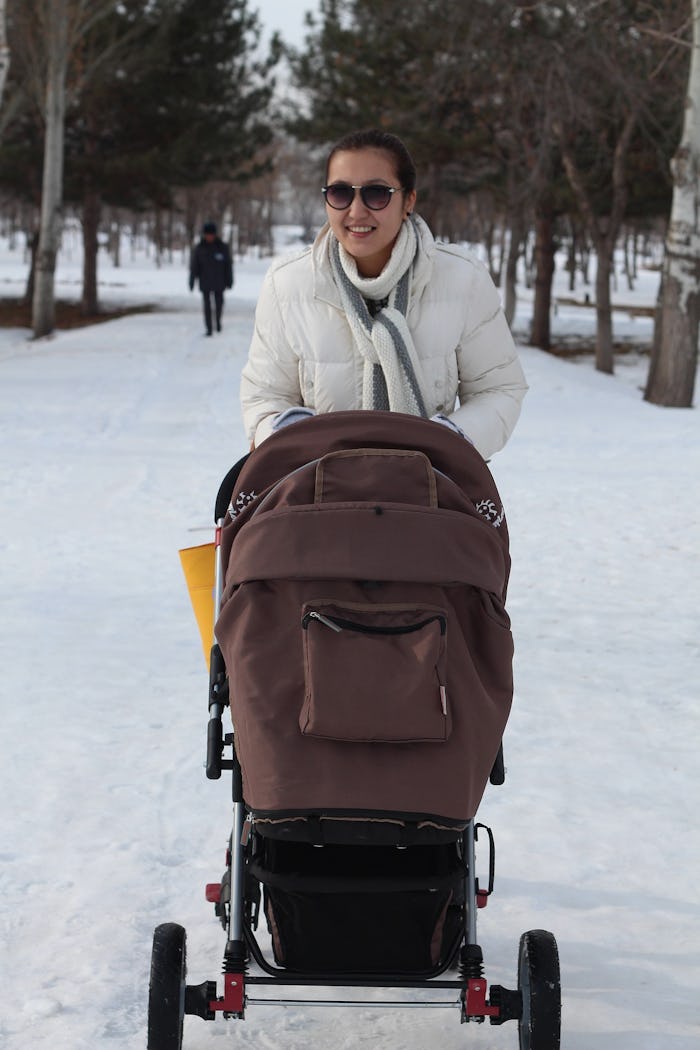Just because you have a infant at home doesn't mean that you have to stay indoors all day — even with the colder months approaching. Babies need fresh air and sunshine, after all, and they can enjoy the outdoors year round with adequate protection. But, if this is your first baby, you might not know how to go for walks in the winter.
As with all things having to do with your baby, you should always use your best judgement when taking an infant out for a walk in the colder weather. Kids under age two are more susceptible to hypothermia and frostbite, according to Parents. So if you're ever in doubt, you should stay in, especially if your baby is under six months old. Pediatrician Jennifer Shu told Parents that young babies can lose heat quickly because they still aren't able to regulate their temperature well.
That said, there are many benefits to spending some time outdoors for children and their parents. Moms who are feeling that postpartum cabin fever can release some of their stress and anxiety by taking a brisk walk. Walking to your neighborhood coffee shop or bakery can brighten your spirits on a cold winter's day. Older siblings can release their energy on a walk to the playground. So to help you save your sanity ad keep baby healthy, here are some tips for taking a walk with your baby this winter.
1Layer, Layer, Layer
Pediatrician Robert Bonner from St. Christopher's Hospital for Children in Philadelphia told Parents that babies 12 months and older require the same amount of clothing as an adult, and younger babies need one extra layer. What To Expect suggested several layers of light- to medium-weight clothing, like cotton and fleece, rather than one big heavy outfit. This way one layer can be easily removed if you are going to stop indoors for a little while or if the weather warms on your walk.
2Accessorize
Because most of your baby's heat escapes through the head, Baby Center warned that hats are a must for babies in the winter. Cover baby's hands with mittens and, if you have a hand-sucker, bring an extra pair or two because wet mittens will make little hands even colder than no mittens at all. Make sure your baby is wearing socks and booties and Parents recommended waterproof boots if your baby is beginning to walk.
3Winterize Your Baby Gear
Parenting suggested using a bunting bag to keep your baby warm on your walk. (For those not in the know, a fitted blanket that goes over a car seat or stroller). There are companies that make zip-up, breathable winter stroller covers to protect your baby from the elements. If you are wearing your baby on your walk instead of pushing a stroller, you may be able to dress your baby in fewer layers, according to Parenting. Just keep a blanket handy in case your baby gets cold.
4Moisturize
Wind and dry air can irritate your baby's skin. What To Expect recommend smoothing fragrance-free, hypoallergenic lotion, cream, or ointment on your baby’s cheeks twice per day. You can also apply baby lip balm or ointment if your little one has chapped lips.
5Protect Baby From The Sun
Just because it's cold doesn't mean your baby's skin isn't susceptible to sun damage. Baby's more than six months of age should use chemical-free sunblocks made with zinc oxide or titanium dioxide, according to Baby Center. Dab a little on exposed skin, like cheeks, every time you take baby outdoors. Sunglasses are also a good idea since the sun bounces off of the snow and can be uncomfortable for your baby's eyes.
6Don't Stay Out Too Long
Baby Center warned parents to be sensitive to their baby's nonverbal signals. A baby who is happy to be out at first, but starts fussing after a while may be feeling cold. Check you baby's fingers, toes, ears, and face regularly while you're out and about to make sure they are nice and warm and not showing signs of frostbite. According to What To Expect, frostbitten skin will feel very cold and look white or yellowish-gray.
If you think your baby has signs of frostbite, open up your coat and shirt, bring your baby next to your skin for warmth, and tuck your baby's hands under your armpits. Then, get to a doctor or emergency room right away. If you can't make it to the ER, immerse the affected area in warm (not hot) water or hold a warm, wet washcloth onto the area for 30 to 60 minutes, until the color returns. Then call your pediatrician.
